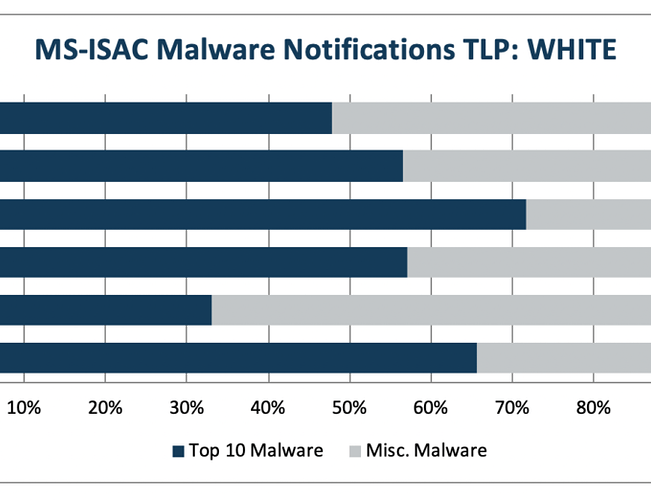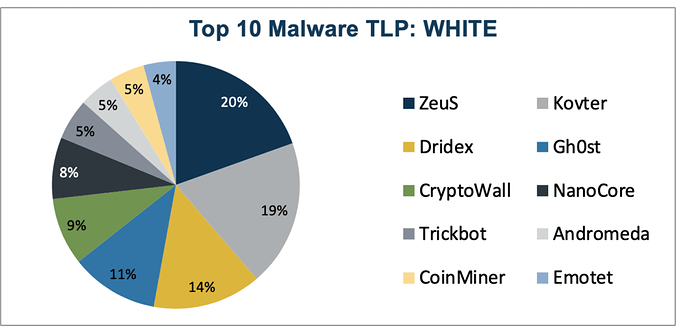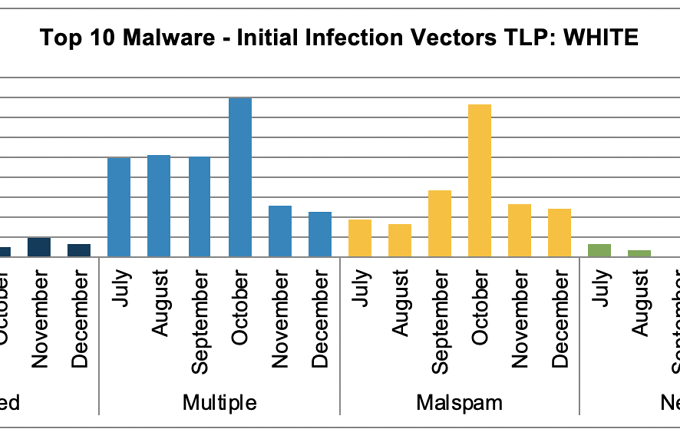The composition of the Top 10 Malware in December remained fairly consistent with the previous month with Emotet and TrickBot once again making an appearance in the Top 10. Overall, the Top 10 Malware variants comprised just 48% of Total Malware activity in December, indicating a departure from the trend of Top 10 Malware variants driving the rate of malware infections. December saw fewer infections across almost every Top 10 malware variant.
In December 2019, malware delivered via malspam accounted for the greatest number of alerts in the Top 10 malware list. The level of activity in the malspam and multiple categories is consistent with the previous month after the MS-ISAC observed fewer TrickBot and Emotet infections following a spike in October. ZeuS, CryptoWall, TrickBot, Andromeda, and CoinMiner alerts account for activity within the multiple infection vector category for the month. Kovter, Dridex, NanoCore, and Emotet drive malspam related infections for the month of December. There is a high likelihood that malspam will continue to remain the preferred initiation vector for malware in the Top 10.
Dropped – Malware delivered by other malware already on the system, an exploit kit, infected third-party software, or manually by a cyber threat actor. Currently Gh0st is being dropped.
Multiple – Malware that currently favors at least two vectors. ZeuS, CryptoWall, TrickBot, Andromeda, and CoinMiner are currently utilizing multiple vectors. ZeuS is dropped by other malware, but it is also delivered via malvertisement. CoinMiner utilizes the malspam and dropped vectors. Andromeda is distributed through malvertisement, exploit kits, and malspam.
Malspam – Unsolicited emails, which either direct users to malicious web sites or trick users into downloading or opening malware. Top 10 Malware using this technique include Kovter, Dridex, NanoCore, and Emotet.
Network – Malware introduced through the abuse of legitimate network protocols or tools, such as SMB protocol or remote PowerShell. WannaCry uses this vector.
- ZeuS is a modular banking trojan which uses keystroke logging to compromise victim credentials when the user visits a banking website. Since the release of the ZeuS source code in 2011, many other malware variants have adopted parts of it’s codebase, which means that events classified as ZeuS may actually be other malware using parts of the ZeuS code.
- Kovter is a fileless click fraud malware and a downloader that evades detection by hiding in registry keys. Reporting indicates that Kovter can have backdoor capabilities and uses hooks within certain APIs for persistence.
- Dridex is a banking trojan that uses malicious macros in Microsoft Office with either malicious embedded links or attachments. Dridex is disseminated via malspam campaigns.
- Gh0st is a RAT used to control infected endpoints. Gh0st is dropped by other malware to create a backdoor into a device that allows an attacker to fully control the infected device.
- CryptoWall is a ransomware commonly distributed through malspam with malicious ZIP attachments, Java Vulnerabilities, and malicious advertisements. Upon successful infection, CryptoWall will scan the system for drive letters, network shares, and removable drives. CryptoWall runs on both 32-bit and 64-bit systems.
- NanoCore is a RAT spread via malspam as a malicious Excel XLS spreadsheet. As a RAT, NanoCore can accept commands to download and execute files, visit websites, and add registry keys for persistence.
- TrickBot is a modular banking trojan that is known to be dropped by Emotet as well as spread via malspam campaigns. TrickBot is also known to download the IcedID banking trojan.
- Andromeda (a.k.a. Gamarue) is a modular botnet and malware dropper. Andromeda is typically spread through malvertiements, malspam, and exploit kits. Known modules for Andromeda include super Keyloggers, form grabbers, proxy modules, and Rootkits. Variants of the Andromeda malware can be purchased online.
- CoinMiner is a cryptocurrency miner that uses Windows Management Instrumentation (WMI) and EternalBlue to spread across a network. CoinMiner uses the WMI Standard Event Consumer scripting to execute scripts for persistence. CoinMiner spreads through malspam or is dropped by other malware.
- Emotet is a modular infostealer that downloads or drops banking trojans. It can be delivered through either malicious download links or attachments, such as PDF or macro-enabled Word documents. Emotet also incorporates spreader modules in order to propagate throughout a network. In December 2018, Emotet was observed using a new module that exfiltrates email content.



